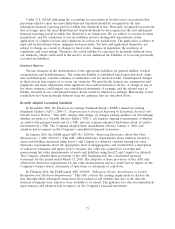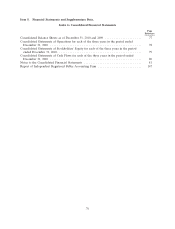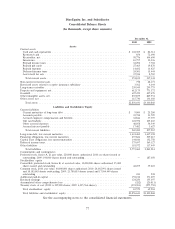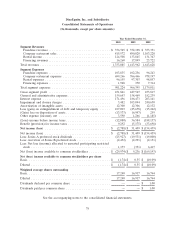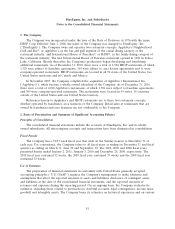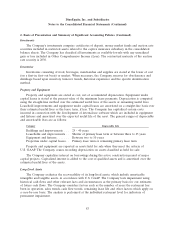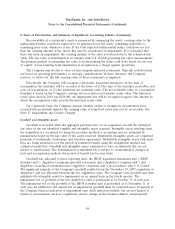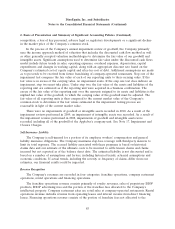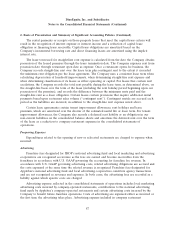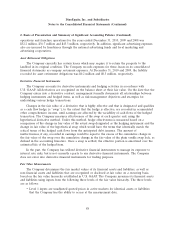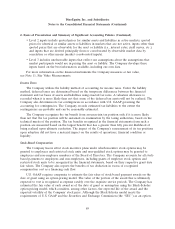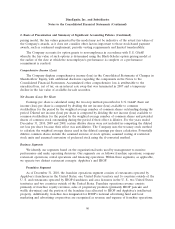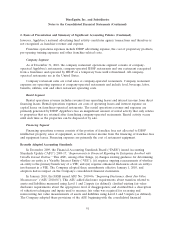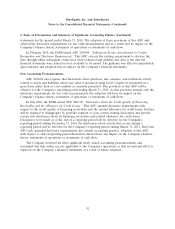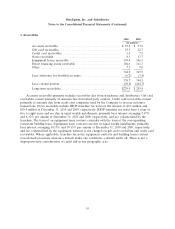IHOP 2010 Annual Report Download - page 99
Download and view the complete annual report
Please find page 99 of the 2010 IHOP annual report below. You can navigate through the pages in the report by either clicking on the pages listed below, or by using the keyword search tool below to find specific information within the annual report.
DineEquity, Inc. and Subsidiaries
Notes to the Consolidated Financial Statements (Continued)
2. Basis of Presentation and Summary of Significant Accounting Policies (Continued)
Investments
The Company’s investments comprise certificates of deposit, money market funds and auction rate
securities included in restricted assets related to the captive insurance subsidiary in the consolidated
balance sheets. The Company has classified all investments as available-for-sale with any unrealized
gain or loss included in Other Comprehensive Income (Loss). The contractual maturity of the auction
rate security is 2030.
Inventories
Inventories consisting of food, beverages, merchandise and supplies are stated at the lower of cost
(on a first-in, first-out basis) or market. When necessary, the Company reserves for obsolescence and
shrinkage based upon inventory turnover trends, historical experience and the specific identification
method.
Property and Equipment
Property and equipment are stated at cost, net of accumulated depreciation. Equipment under
capital leases is stated at the present value of the minimum lease payments. Depreciation is computed
using the straight-line method over the estimated useful lives of the assets or remaining useful lives.
Leasehold improvements and equipment under capital leases are amortized on a straight-line basis over
their estimated useful lives or the lease term, if less. The Company has capitalized certain costs
incurred in connection with the development of internal-use software which are included in equipment
and fixtures and amortized over the expected useful life of the asset. The general ranges of depreciable
and amortizable lives are as follows:
Category Depreciable Life
Buildings and improvements . . . 25 - 40 years
Leaseholds and improvements . . Shorter of primary lease term or between three to 25 years
Equipment and fixtures ....... Between two to 10 years
Properties under capital leases . . Primary lease term or remaining primary lease term
Property and equipment are reported as assets held for sale when they meet the criteria of
U.S. GAAP. The Company ceases recording depreciation on assets classified as held for sale.
The Company capitalizes interest on borrowings during the active construction period of major
capital projects. Capitalized interest is added to the cost of qualified assets and is amortized over the
estimated useful lives of the assets.
Long-Lived Assets
The Company evaluates the recoverability of its long-lived assets, which include amortizable
intangible and tangible assets, in accordance with U.S. GAAP. The Company tests impairment using
historical cash flows and other relevant facts and circumstances as the primary basis for our estimates
of future cash flows. The Company considers factors such as the number of years the restaurant has
been in operation, sales trends, cash flow trends, remaining lease life and other factors which apply on
a case-by-case basis. The analysis is performed at the individual restaurant level for indicators of
permanent impairment.
83


